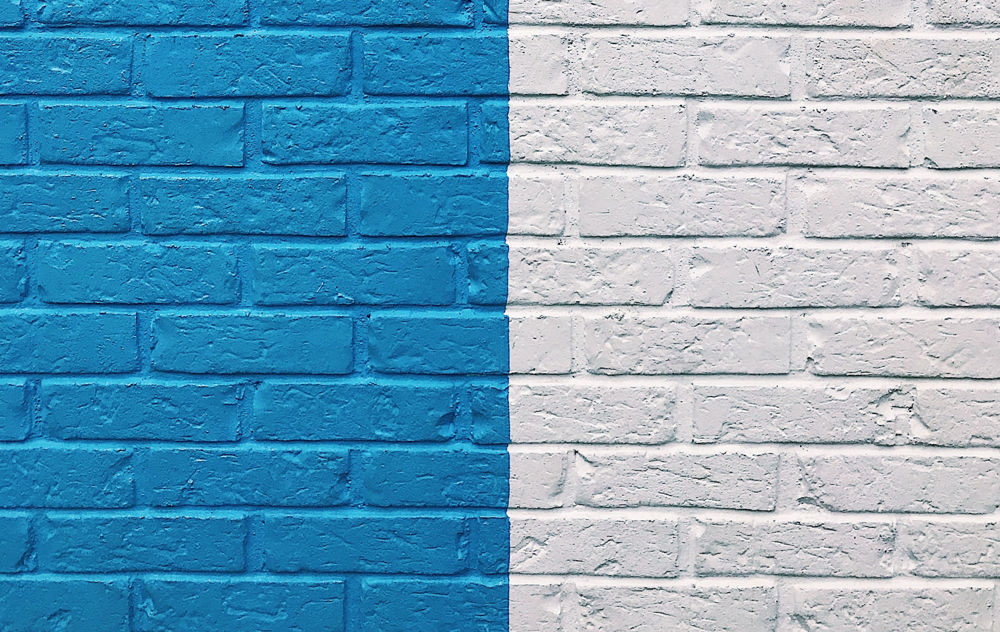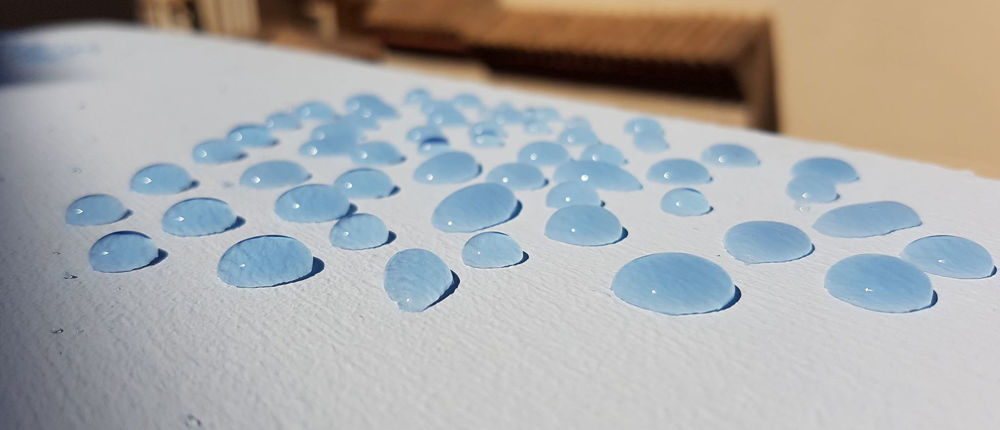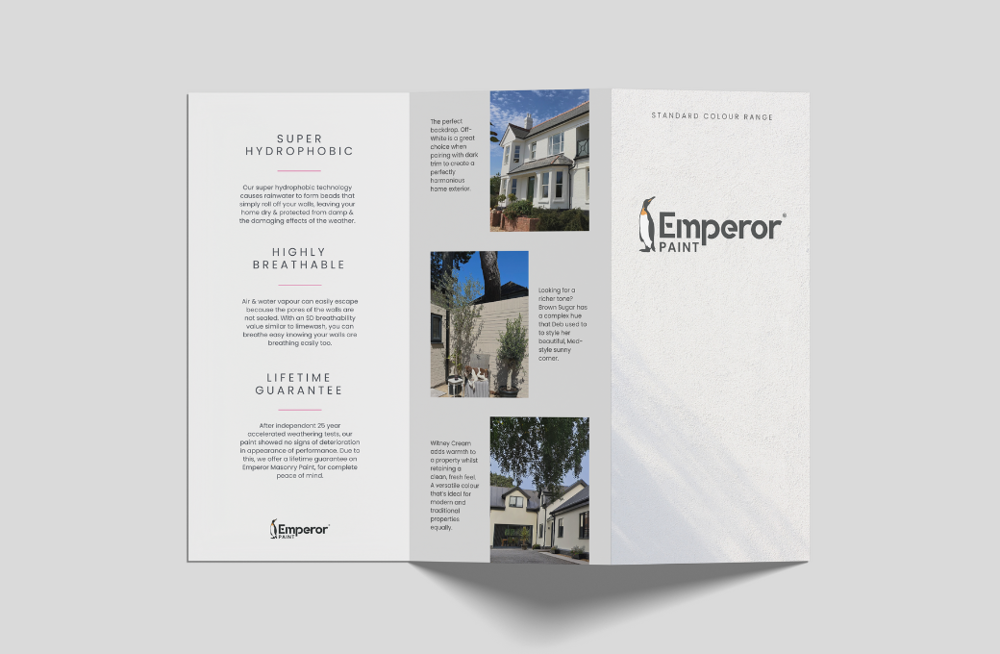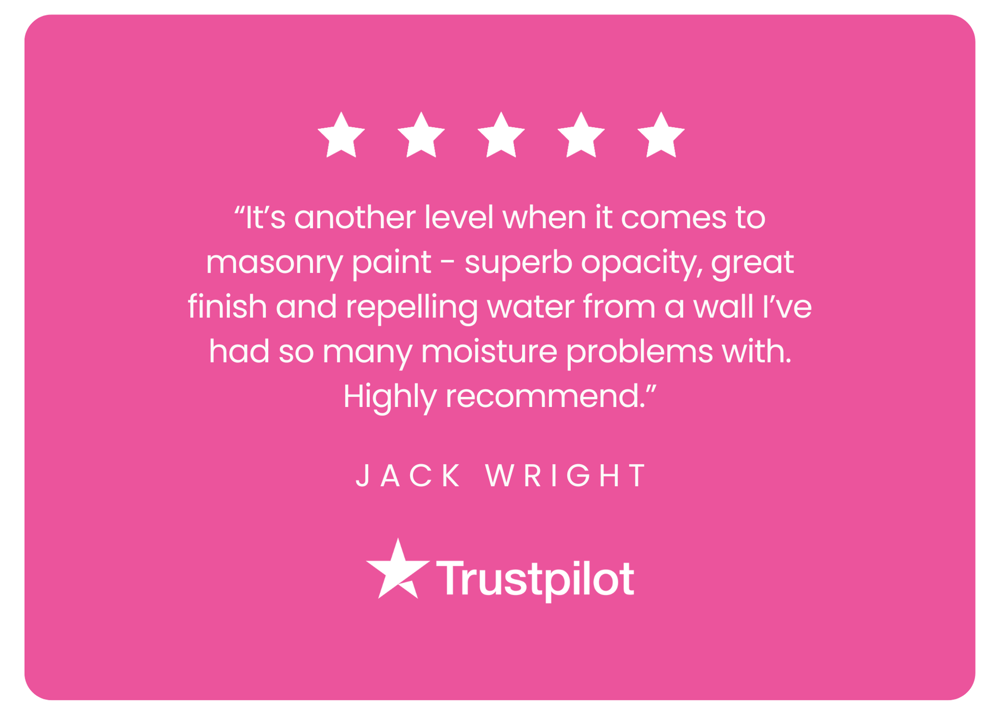
When the weather warms up, one of the most popular DIY projects is painting exterior brick walls, be it the full exterior of your home or a garden wall. Importantly, if you want beautiful, long-term results it is important to know what you are doing, which is why our experts have put together this handy guide to painting exterior brick walls, so you can find all the information you need in one place.
Painting Exterior Brick
Painting exterior brick walls is something that can be done by anyone if you do the right research. The first step in the process is to ensure that you are using the correct paint. Due to the weathering that exterior surfaces must endure, you must use a paint that can deal with exposure to wind and rain. You must also use a paint that is suitable to be applied to brick. Masonry paint is a form of exterior paint that is specially designed for use on exterior walled surfaces, including render, stone & brick. There are a number of forms of masonry paint to choose from, including acrylic-based masonry paint, silicone-based masonry paint & oil-based masonry paint.
ACRYLIC MASONRY PAINT
Acrylic-based masonry paint is the most common type of masonry paint that you will find. They are water-based formulations that contain an acrylic binder within their makeup. While acrylic masonry paints are weatherproof, they are not completely waterproof, which can lead to them being suspectible to water ingress. Furthermore, they generally have low breathability due to the plastic content in the paint that prevents water vapour from easily passing through the surface.
This can lead to any moisture that is absorbed by the coating getting stuck underneath the paint film, causing the paint to peel & flake, which is why acrylic masonry paints come with a lifespan of 3-15 years, with the 15 year lifespan being estimated under the best possible weather conditions. Acrylic-based masonry paint is ideal if you are looking for a short-term colour change for a small brick wall, although if the wall is likely to be exposed to heavy weathering, it may discolour.
SILICONE MASONRY PAINT
Silicone masonry paint is a technologically advanced form of masonry paint that contains silicone-resins within its formulation. Silicone masonry paint is used much in the same way as water-based masonry paint, as it can be diluted and cleaned using water. These added resins make silicone masonry paint water repellent & highly breathable, which in combination allow it to keep exterior brick completely dry. As water is the biggest cause of paint degradation, by keeping exterior walls dry silicone masonry paint is extremely durable, often coming with a 20+ year lifespan. Another big benefit of silicone masonry paint is that while it can be used on all substrates, it is highly compatible with silicone renders which is not the case with all masonry paints.
OIL-BASED MASONRY PAINT
Oil-based masonry paint, otherwise known as pliolite, is a reserved solely for applying in conditions below 5°C or to prevent the paint from washing off straight after application due to rainfall. While weather resistant, pliolite has a very low breathability, meaning it is only suitable for use in certain commercial circumstances. Having previously been a popular form of masonry paint, oil-based masonry paint has it has been surpassed by more advanced technology & is very rarely used by homeowners today.
Things To Consider
Before starting with the painting, there are a few things to consider in order to ensure you achieve the best possible results.
WATER INGRESS
Contrary to what some homeowners believe, building materials such as brick, concrete and stone are porous, meaning water can be absorbed into the structure through a process called ‘capillary action’. The more porous a material, the more water it can absorb. This moisture can be bad news for paintwork, as moisture is the single biggest cause of paint failure. As we have mentioned, acrylic-based masonry paint will not prevent moisture from gathering underneath the paint film as they are not waterproof. This moisture will eventually cause the paint film to lift off the brick, causing the paint to peel & flake.
Even before the paint is applied moisture can be a problem. Exterior brick walls must be below 8% moisture content to be suitable to paint, as high moisture levels can impact the ability for the paint to adhere to the surface. This moisture content can be measured using electronic moisture meter if you want to ensure your bricks are at an adequate moisture level.
There are a number signs that you may have a problem with water ingress if you cannot get your hands on an electronic moisture meter. If your bricks are damaged, such as spalling brick faces or crumbling mortar, this is a key indicator that the bricks are deteriorating. An easily visible sign of water ingress is dark discolouration on the exterior brick or any natural growth such as moss, lichens & green stains that are caused by high moisture conditions. Lastly, if you are suffering from penetrating damp, this is possibly the most important sign that your exterior bricks suffer from water ingress. This penetrating damp is caused by rainwater absorbing from the exterior wall through to the interior wall, causing mould growth.
EFFLORESCENCE
The chances are, if you are not familiar with the term efflorescence, you are familiar with the sight of it. Efflorescence is a white, powdery substance that stains exterior brick walls. It is caused by water soluble salts that are dissolved by water when it penetrates into brickwork. When this water eventually evaporates, the salt deposits are drawn to the surface of the brick, leaving an unsightly white coating. While this efflorescence will not cause damage itself, it is a sign that your exterior brick walls are susceptible to water ingress. Furthermore, this efflorescence must be removed in order to paint the surface. While large amounts of the salt will come off with the cleaning process before painting, deep ingrained efflorescence can be harder to remove.

HEAT LOSS
In the case of exterior walls of properties, heat loss is a factor to consider when painting. This is because damp content of 5% can lower the insulating properties of a brick wall by 50%. Over 35% of the heat lost in a property comes from the exterior walls, meaning keeping exterior brick walls dry can significantly improve the energy efficiency of a household. A water repellent masonry paint like silicone masonry paint can prevent exterior brick walls from absorbing moisture, which reduces the transfer of heat.
Breathability
Breathability is a crucial factor when choosing which masonry paint to use. Non-breathable masonry paint seals the pores of masonry, trapping moisture & ultimately causing the moisture to build-up within the substrate. If this happens over a period of time, this moisture will lead to significant deterioration in building integrity and cause damage that cannot be undone. An SD value is a measurement that is used to demonstrate the breathability of a substrate, otherwise known as its ability to allow water vapour to freely travel through the material. A substrate with an SD value of 0.5 or below is considered breathable. If a paint does not have an SD value of below 0.5, you should avoid using it as you will cause more damage than good to your exterior brick walls.
If you are deciding what masonry paint to use, you must consider what level of protection & durability you are looking to achieve. If you are looking for a short-term solution to paint exterior brick walls, an acrylic-based masonry paint may be suitable. It is important to remember that this will be susceptible to water ingress and could peel or flake in a matter of years. Having said this, if you are planning to change the colour of the brick regularly, this could be a low-cost option. If you are painting the full exterior walls of your property or have problems relating to water ingress, it is recommended that you opt for a more advanced water repellent & breathable silicone masonry paint that will stand the test of time. Like with any DIY project, doing it right first time round means you will only have to do it once.
Super Hydrophobic Technology
To solve the numerous problems that masonry paint can have, we developed our highly advanced nano-technology here at Emperor Paint.
Emperor Masonry Paint is a silicone masonry paint that has been designed to offer high breathability, as well as water repellent protection that completely waterproofs exterior brick walls. It achieves this by creating a super hydrophobic surface on exterior brick that means any rainfall simply falls straight off the painted surface. The nano technology lines the pores of brick while not sealing them completely, allowing water vapour freely pass through them but not water. This means while water cannot absorb into the wall, any moisture already in the wall can freely evaporate out.
In independent tests conducted by UKAS accredited laboratory Lucideon, Emperor Masonry Paint was found to have an SD value of 0.03 and prevented water absorption by 96%. It was also tested in a 25-year accelerated weathering process, which found that after 25 years of heavy weathering, it showed no signs of change in appearance or performance. This 25-year performance was under harsh weather conditions where the paint was tested to the extremes of the weather, from freezing temperatures to extremely heavy rain. Due to this, Emperor Masonry Paint comes with a lifetime guarantee, ensuring its performance in all weather conditions. This ensures that Emperor Masonry Paint will never peel or flake as the moisture that causes this is prevented.
The other significant benefits of super hydrophobic technology is that it is self-cleaning and heat retaining. Just like water cannot attach to the painted surface, neither can dirt. Any dirt or debris simply washes off the surface with any rainfall. Furthermore, the moisture that allows fungal growth such as moss & lichens to grow on the brick wall is prevented, significantly reducing the discolouration that painted brick usually undergoes. Lastly, by keeping brick walls dry, Emperor Masonry Paint helps to improve the heat retention of exterior walls, which was demonstrated during the independent testing. A brick wall left unpainted was found to be on average 6°C colder than the brick wall painted with Emperor Masonry Paint. For this reason, Emperor Masonry Paint has been verified by the Energy Saving Trust following their independent review process.

How To Paint Masonry
Now you have your paint sorted, it is time to start the decorating process. Here is our experts step-by-step guide to painting masonry from start to finish.
To paint exterior brick you will need:
- Masonry paint
- Masonry roller (long-pile roller)
- Paint tray or scuttle
- Paint brush
- Dust brush
- 120 grit sandpaper
- Dust sheets
- Window film
- Masking tape
- Exterior filler & filling knife (may be required)
- Scraper (may be required)
1. PREPARATION
Preparation is one of the most important parts of the decorating process, as any professional decorator will tell you. Do not rush this step as it will cost you in the long-run. If you do not ensure the surface is ready to paint, you will experience problems with the paint adhering either during the painting or after a matter of weeks the paint will begin to fail.
The very first part of the process for preparing exterior brick to be painted is to fill any cracks or holes in the wall. This not only helps to give you the best possible finish once it has been painted, but also helps to keep the wall watertight. Start by removing any loose mortar and rubble from any holes or cracks you have before filling. Using a good exterior filler such as the Toupret Masonry Repair Filler, fill the brick by working the filler back and forth into hole or crack. If it is only a small hairline crack, it is recommended to make the crack larger in order to help the filler do its job. Using a multi-purpose tool, rake out the crack to widen it. It is a good idea to overfill the hole to ensure that you compensate for shrinkage. If you have overfilled, sand this back using a 120-grit sandpaper to get a perfectly smooth surface ready to paint. On any areas where paint is peeling, remove this using a scraper. If the scraper doesn't work use a stiff-bristled brush.
Once the surface is properly filled and sound, it must be cleaned before you paint. If you leave any fungus left on the wall, this will bloom and cause the paint to fail when it grows underneath the paint film. Any dirt on the brick can also get between the brick and the paint, causing it to not adhere properly. Wash the brick wall down with a hose pipe to remove any dirt or debris. If you have any efflorescence, give this a brush down using a stiff brush. On any areas that show mould or green growth, apply a fungicidal masonry cleaner such as Emperor Masonry Cleaner using a brush. Allow it to dry and be absorbed into the surface of the brick for a minimum of 2 hours. It is not necessary to wash this off as you will be painting over the top of it and therefore will not see the residue left by the cleaner.
The final part of the preparation process is to mask any surfaces that you do not want to paint in order to achieve the neatest possible finish. Apply masking tape along any the edges of the wall and your exterior trim such as doors and windows. It is also recommended to put down dust sheets to reduce the risk of paint splashing on to the floor.
2. PRIMING
If you are painting a bare exterior brick, you must prime it like most other bare surfaces before painting. This is because the paint will absorb into the brick rather than create a solid paint film. On small areas where you have removed failing paint, you can apply a diluted coat of masonry paint as a form of priming layer, although this is not recommended for large areas. Simply add 10% water by volume to Emperor Masonry Paint and apply to the bare area before you paint the full wall. If you are simply refreshing previously painted brickwork, you do not need to apply a primer.
When using Emperor Masonry Paint, you must use the Emperor Paint Primer as this is also water repellent, ensuring full waterproof protection. If you used a standard primer or stabilising solution, this would not allow for best performance of the paint when it is applied. Many people ask whether they should apply a stablising solution to help prepare any chalky surfaces. A primer acts as a stablising solution, while not all stabilising solutions act as a primer, so there is no need to apply one while using a primer.
Masonry primer is a thin, milky substance that can be easily applied using either a roller or a paint brush. You only need to apply one coat of the primer before applying the paint. If conditions are not dry, do not attempt to continue with the painting process as the primer will not adhere. Apply a thin, even layer of the primer to the brick, ensuring you cover the full surface. Once you have fully primed the area, leave it to dry completely for 3-5 hours before painting.
3. PAINTING
Ensure you are not painting in conditions below 5°C as any water-based masonry paint will not dry in these conditions. Starting from the top of the brick wall, use a paint brush to cut in around the edges first as these can then be rolled over with a roller to create an even finish. Once this is done, use your long-pile masonry roller to apply a thin but even first coat of paint. You could also use a medium-pile roller, however a long-pile roller has the longest fibres, allowing you to easily paint in any nooks and crannies in the brick. You could also use a spray machine, however this should only be used by experienced spray professionals.
The aim of this first coat is not create a solid colour finish but to build an undercoat that will help the topcoat adhere. Once you have finish your first coat, leave to completely dry as per the manufacturers instructions. In the case of Emperor Masonry Paint this is around 8 hours. Apply the second coat slightly thicker but once again as evenly as possible to the brickwork, ensuring that you are achieving your desired finish as Emperor Masonry Paint will cover in two coats. Leave your second coat to completely dry before you remove your masking tape and admire your handy work!
Frequently Asked Questions
Q. WHAT COLOURS ARE AVAILABLE?
Emperor Masonry Paint is available in 18 popular exterior colours, including white, off-white, light grey & magnolia.

Q. HOW MUCH PAINT WILL I NEED?
Estimating how much paint you will need to paint your exterior brick wall can seem difficult, however it can be simple. The amount of paint you will need depends on three things:
- The size of the wall
- The coverage of the paint your are using
- The number of coats required
Start by measuring the height and length of the wall your are painting, in metres. If you are painting multiple walls or sides of the house, splitting these into separate figures will help to get an accurate figure. Once you have the measurements, multiply these together to give yourself a square metres figure. If you are painting a full house which has walls 4m high and 5m long, this would leave you 20m² per wall, which would be 80m2 in total.
The coverage of Emperor Masonry Paint is 5-6m² per litre. Remember, you will need two coats of paint, meaning you will need double the amount of paint you calculate. An 80m² house at 5-6m² per litre coverage would mean you would need 13L of paint for one coat and 26L of paint for two coats.
Read our full guide on how to estimate how much paint you will need, for more information.
We hope we have answered any questions you may have had regarding painting exterior brick. Why not order a sample pot of Emperor Masonry Paint or talk to one of our experts by emailing info@emperorpaint.co.uk?


